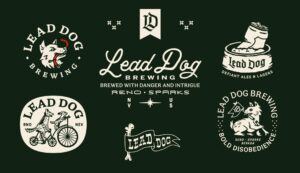A Strategic Approach to Personality, Identity, and Visual Creation
How do industry-leading companies become industry leaders? From the inception of their company, the most successful businesses have a strategy behind how customers perceive their brand. But can every business implement a brand strategy like the big guys?
This comprehensive guide delves deep into the core elements of brand development, including — developing brand personality, understanding brand identity elements, and mastering visual identity creation—to ensure your brand resonates with its audience and stands out in a crowded marketplace.
What is Brand Development
Brand development is the strategic process of creating and distinguishing your company’s image, products, and services from your competitors. It involves aligning your brand with your business objectives, communicating it to your target market through various channels, and updating or maintaining it as your market evolves.
Creating an effective brand is crucial in today’s environment as it builds brand recognition and loyalty among consumers and drives business growth.
What Does the Brand Development Process Look Like?
The process might look a little different depending on who’s leading your brand development strategy. But, at Commence Studio, we lead our partners through a repeatable process that turns apathetic followers into brand evangelists.
Check out our latest work, in which we rebranded Nevada’s favorite brewery.
But this wouldn’t be much of a guide if we didn’t pull back the curtains a little bit, would it? So, let’s dive a bit deeper into those components so you can find out precisely what a brand development strategy looks like.
The key components to our process include:
Brand Strategy
You can’t have a strategy without research – we consider this the groundwork stage. We gather a lot of information to understand the company we are branding. This involves learning about the company’s goals, target audience, market position, and competitors. The information gathered here can help shape the latter steps in the process. Understanding the market and customer needs gives us a foundation to build.
Brand Positioning
Next, we help define the brand’s core elements. This involves setting a clear brand mission (what the brand aims to achieve), vision (what the brand aspires to be), and values (the guiding principles of the brand). Additionally, they establish the brand’s personality—how it should communicate and behave. This step sets the direction for all future branding efforts and can help guide internal and external communications.
Need help creating your brand’s positioning? Here are four questions to ask your stakeholders.
Why does our company exist?
What is the future that we envision for your brand?
How can we create the future that we want to see?
What are the essential values that will guide our business going forward?
Brand Identity
Now that the strategy and positioning are set, it’s time to create a visual style that reflects the brand’s identity. This includes designing the logo, selecting a color palette, and creating typography and other visual elements. These components need to visually communicate what the brand stands for and appeal to the target audience, similar to choosing an outfit that reflects your personality and intentions.
Promotional Strategy
With the visual identity in place, the next step is deciding how to communicate the brand to the audience. This involves crafting the key messages the brand wants to convey and selecting the appropriate channels to reach the audience, whether through social media, advertisements, email campaigns, or other media. The goal is to ensure the brand’s message is consistent and engaging across all platforms.
Putting It All Together
Implementing an effective brand development strategy requires thoughtful integration of all elements—personality, identity, and visual design. By carefully developing each aspect, you can ensure your brand attracts attention and builds lasting connections with its audience.
Looking for help with your own brand strategy execution? We want to hear from you.
But what happens when the process is rushed and isn’t properly executed? Brands can still succeed, right?
The Risks of Developing a Brand Without Strategy
The cyber streets are littered with companies whose logos and broader visions aren’t backed by strategy. With the increase of dropshipping and white labeling, it’s easier than ever to create a company that sells products, but the thing that those companies are missing is obvious.
- Lack of Differentiation: Without a clear brand strategy, it can be challenging for a company to distinguish itself from competitors. This lack of differentiation may lead to difficulty in gaining market share as potential customers may not see a compelling reason to choose your products or services over others.
- Confused Messaging: A brand strategy helps ensure consistent messaging across all platforms and touchpoints. Without it, the company’s messaging can become inconsistent and confusing, potentially alienating the target audience and diminishing the effectiveness of marketing efforts
- Missed Target Audience: A brand strategy typically includes clearly defining the target audience. Without this focus, a company might fail to connect effectively with the right customers, leading to inefficient use of marketing resources.
- Weak Customer Loyalty: Branding plays a crucial role in building customer loyalty. Without a strong brand identity design and strategy, creating emotional attachments with customers becomes difficult. This lack of connection can result in lower customer retention rates.
- Ineffective Marketing: A clear brand strategy guides marketing campaigns, promotional strategies, and communication plans. Without it, marketing efforts may lack focus, leading to poor returns on investment and wasted resources.
Brand Strategy Examples
Are you a visual learner? Great! So are we, and it’s easier to understand brand development strategy with a few examples.
Blind Dog Coffee – Rebrand and packaging for a community-focused coffee roaster

Our CEO, Matt McIver, says this, “Behind every great brand, there is an equally inspiring story. The Blind Dog Coffee story teaches us to overcome our struggles and that our biggest challenges can become our biggest opportunities. What do you get when you combine brand strategy with a quirky, playful coffee roaster? A dog-gone good time.”
After years of success in the local market, it was time to discuss expansion. Blind Dog Coffee’s old logo and packaging didn’t match their national-level competition. Their story about owner Mark Berry, who developed blindness after a cancer diagnosis, needed representation that was lacking previously.
The updated brand identity and packaging system modernized the front and strategically color-blocked primary products to make them even more recognizable. The fan-favorite—Nevada Black, an Italian Roast—can be seen in an all-black color block with artistic accents down the side representing the iconic Nevada cowboy.
After asking customers and researching alternatives on the shelves, we spotlighted their unique story backed by a charitable cause. “They deserved something that stayed true to themselves but was able to compete with the big players on the shelf,” says McIver.
The rebrand stayed true to the makers behind the coffee while listening to consumer trends to create a look inspired by the company’s culture.
Brewery Branding for Lead Dog Brewery

Before collaborating with Commence Studio, Lead Dog had joined forces with Mammoth Brewing. Subsequent to this merger, Lead Dog’s visual design was handled by various freelance artists from Fiverr, resulting in a lack of consistent style. With a lineup of 24 rotating beers and a goal to build a recognizable brand presence from one release to the next, they recognized the necessity for improved branding and packaging strategies to support their rapidly expanding Limited Time Offerings.
Our engagement started by partnering with their Vice President of Marketing to compile Nielsen data and conduct consumer research and surveys. This effort aimed to capture insights into craft beer consumer preferences and perceptions of Lead Dog’s offerings. From this research, we distilled the core attributes of the brand: adventure, quality, and diversity.
The main obstacle was enhancing brand recognition in taprooms and retail outlets featuring Lead Dog’s products. Their previous logo, which featured a stylized dog’s head encircled by text, did not maintain clarity when resized. They required a design system that would seamlessly integrate with other elements of the brand identity, including pallets, merchandise, and more than 24 beer can labels, as well as larger-scale items like 14-foot signs, social media posts, and website icons.
The work we created differentiated their brand from local and national competition through design backed by data and customer sentiment. Check out the full case study here.
Conclusion
In conclusion, a dynamic brand development strategy is essential for any business aiming to thrive in a competitive market. By focusing on developing a unique brand personality, refining your brand identity design, and meticulously creating a cohesive visual identity, your brand is well-positioned to resonate with your audience and achieve sustainable growth.
Implementing these strategies with an internal team can be hard, but hiring a brand identity studio can take some of the pressure off of your team. At Commence Studio, we’re experts in everything from brand development, Shopify web development, rebranding strategies, and brand marketing. As the go-to studio for e-commerce branding, we can help you separate from the competition and create sustainable growth online and in-store.
